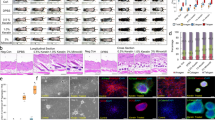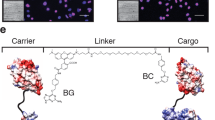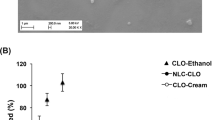Abstract
Loss of hair and hair colour is associated with ageing, and when it involves the scalp hair, it can be distressing to both sexes. Hair loss resulting from cancer chemotherapy is particularly distressing. However, safe, effective therapies directed to hair have only just started to be developed. The hair follicle is a complex skin appendage composed of epidermal and dermal tissue, with specialized keratinocytes, the hair matrix cells, forming the hair shaft. Specific therapy of the hair follicle depends on selective targeting of specific cells of the hair follicle. We have developed the histoculture of intact hair-growing skin on sponge-gel matrices1–6. We have recently found in histocultured skin that liposomes can selectively target hair follicles to deliver both small and large molecules3–6. That liposomes can target the hair follicle for delivery has been confirmed independently7. Two decades ago we introduced the technique of entrapping DNA in liposomes for use in gene therapy8. In this report we describe the selective targeting of the lacZ reporter gene to the hair follicles in mice after topical application of the gene entrapped in liposomes. These results demonstrate that highly selective, safe gene therapy for the hair process is feasible.
This is a preview of subscription content, access via your institution
Access options
Subscribe to this journal
Receive 12 print issues and online access
$209.00 per year
only $17.42 per issue
Buy this article
- Purchase on Springer Link
- Instant access to full article PDF
Prices may be subject to local taxes which are calculated during checkout
Similar content being viewed by others
References
Li, L., Margolis, L.B. & Hoffman, R.M. Skin toxicity determined in vitro by three-dimensional, native-state histoculture. Proc. natn. Acad. Sci. U.S.A. 88, 1908–1912 (1991).
Li, L., Margolis, L.B., Paus, R. & Hoffman, R.B. Hair shaft elongation, follicle growth, and spontaneous regression in long-term, gelatin sponge-supported histoculture of human scalp skin. Proc. natn. Acad. Sci. U.S.A. 89, 8764–8768 (1992).
Li, L., Margolis, L.B., Lishko, V.K. & Hoffman, R.M. Product-delivering liposomes specifically target hair follicles in histocultured intact skin. In Vitro cell. dev. Biol. 28A, 679–681 (1992).
Li, L., Lishko, V.K. & Hoffman, R.M. Liposomes can specifically target entrapped melanin to hair follicles in histocultured skin. In Vitro cell. dev. Biol. 29A, 192–194 (1993).
Li, L., Lishko, V.K. & Hoffman, R.M. Liposome targeting of high molecular weight DNA to the hair follicles of histocultured skin, A model for gene therapy of the hair growth processes. In Vitro cell. dev. Biol. 29A, 258–260 (1993).
Li, L., Lishko, V.K. & Hoffman, R.M. High efficiency liposome-mediated transfection of the tyrosinase gene to cultured cells: A model for the gene therapy of hair color restoration. In Vitro cell. dev. Biol. 30A, 135–138 (1994).
Yarosh, D. et al. Localization of liposomes containing a DNA repair enzyme in murine skin. J. Invest. Dermatol. 103, 461–468 (1994).
Hoffman, R.M., Margolis, L.B. & Bergelson, L.D. Binding and entrapment of high molecular weight DNA by lecithin liposomes. FEBS Lett. 93, 365–368 (1978).
Cotsarelis, G., Sun, T.T. & Lavker, R.M. Label-retaining cells reside in the bulge area of pilosebaceous unit: Implication for follicular stem cells, hair cycle and skin carcinogenesis. Cell 61, 1329–1337 (1990).
Caplen, N.J. et al. Liposome-mediated CFTR gene transfer to the nasal epithelium of patients with cystic fibrosis. Nature Med. 1, 39–46 (1995).
Shibahara, S., Tomita, Y., Tagami, H., Muller, R.M. & Cohen, T. Molecular basis for the heterogeneity of human tyrosinase. J. exp. Med. 156, 403–405 (1988).
Tanaka, S., Yamamoto, H., Takeuchi, S. & Takeuchi, T. Melanization in albino mice transformed by introducing cloned mouse tyrosinase gene. Development 108, 223–227 (1990).
Author information
Authors and Affiliations
Rights and permissions
About this article
Cite this article
Li, L., Hoffman, R. The feasibility of targeted selective gene therapy of the hair follicle. Nat Med 1, 705–706 (1995). https://doi.org/10.1038/nm0795-705
Issue Date:
DOI: https://doi.org/10.1038/nm0795-705
This article is cited by
-
Strengthening the Skin with Topical Delivery of Keratinocyte Growth Factor-1 Using a Novel DNA Plasmid
Molecular Therapy (2014)
-
Hair multiplication with dermal papilla like tissue containing human dermal papilla cells
Biotechnology and Bioprocess Engineering (2014)
-
Optimization of the reconstruction of dermal papilla like tissues employing umbilical cord mesenchymal stem cells
Biotechnology and Bioprocess Engineering (2010)
-
Nanoparticle-Based Targeting of Vaccine Compounds to Skin Antigen-Presenting Cells By Hair Follicles and their Transport in Mice
Journal of Investigative Dermatology (2009)



